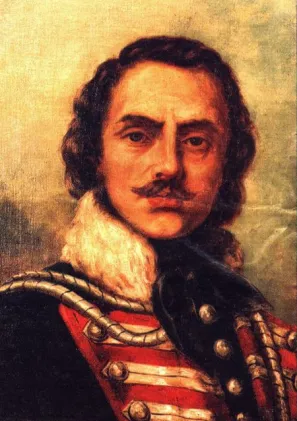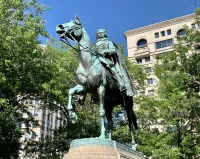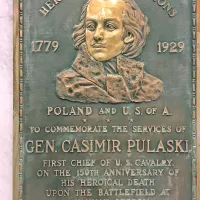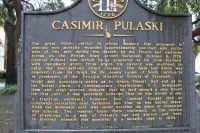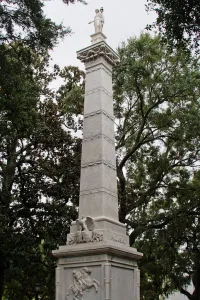Biography
1745 - 1779
“I came here, where freedom is being defended, to serve it, and to live or die for it."
-Casimir Pulaski
Polish nobleman Casimir (Kazimierz) Pułaski arrived in the American colonies during the Revolutionary War. Though lauded as a hero for his role in the fight for Poland’s independence against Russian encroachment [“Barska Konfederacja” [1768–72)], Pulaski was unable to help Poland prevail when Austria and Prussia invaded in 1772. He fled to Saxony, and then to France, where he lived in poor financial straits until a meeting in Paris with Benjamin Franklin, in December 1776, forever changed his life. Pulaski told Franklin he wanted to help America fight for its independence from Britain. Franklin was so impressed with Pulaski that he sent a letter of recommendation to General George Washington who agreed to take him into his ranks. Almost immediately after his 1777 arrival in Massachusetts, Pulaski proved his mettle by saving Washington’s life – and the Continental Army from horrible defeat – in the Battle of Brandywine. On September 15, 1777, immediately following that victory, the Continental Congress promoted Pulaski to Brigadier General in command of the cavalry. In May 1778, he formed a special cavalry unit which used the guerrilla warfare tactics he taught his soldiers in battles along the New Jersey coast. “The Pulaski Legion” also guarded the northern border of Pennsylvania before heading south to successfully defend Charleston, South Carolina in May 1779. Pulaski was wounded by grapeshot on October 9, 1779 during the Siege of Savannah – a battle which failed to wrest control of the city from the British. He died from his wounds on October 15 while on board a ship en route to Charleston to escape the British. He was 34 years old. His body was brought ashore and buried at Greenwich Plantation. In the 1850s, it was exhumed to be re-interred at the foot of the Casimir Pulaski Monument in Savannah. When the monument was set to be repaired in 1996, researchers were able to see if Pulaski’s remains were actually buried there when his skeleton was exhumed. Upon close examination of his remains, a forensic anthropologist determined that the pelvic bone, delicate face and rounded jaw line were those of a woman. This revelation understandably led most to believe the body which had been entombed at the Pulaski Monument was not his. However, the skeleton’s short stature and young age, the pelvic scarring associated with extensive horseback riding, and a hand injury which matched one Pulaski sustained in battle, all suggested it was… raising the possibility that Casimir Pulaski had been intersex. A DNA test in the 1990s was inconclusive; but a second DNA test in 2018 – using a bone fragment from a Polish relative who died in the 1800s – showed that the remains were, indeed Pulaski’s. Many honors have been bestowed on Pulaski including a Georgia Military Hall of Fame induction; an America Heroes bust at the U.S. Capitol; a statue in Washington D.C.’s Freedom Plaza; the inauguration of General Casimir Pulaski Day on October 11 in honor of Chicago’s large Polish community; the State of Illinois making Pulaski’s birthday a state holiday; and being granted honorary United States citizenship - one of only eight people to be so honored – in 2009... all of which took place before a 2019 Smithsonian Channel documentary “The General was a Female?” revealed that Pulaski had actually been intersex. Like the revelation that the United States first Secretary of War, General Friedrich von Steuben, had been a gay man, the deconstruction and re-writing of Casimir Pulaski’s legend has further affirmed the importance of the many roles LGBTQAI people played in the success of the American Revolution.
1745 - 1779
“I came here, where freedom is being defended, to serve it, and to live or die for it."
-Casimir Pulaski
Polish nobleman Casimir (Kazimierz) Pułaski arrived in the American colonies during the Revolutionary War. Though lauded as a hero for his role in the fight for Poland’s independence against Russian encroachment [“Barska Konfederacja” [1768–72)], Pulaski was unable to help Poland prevail when Austria and Prussia invaded in 1772. He fled to Saxony, and then to France, where he lived in poor financial straits until a meeting in Paris with Benjamin Franklin, in December 1776, forever changed his life. Pulaski told Franklin he wanted to help America fight for its independence from Britain. Franklin was so impressed with Pulaski that he sent a letter of recommendation to General George Washington who agreed to take him into his ranks. Almost immediately after his 1777 arrival in Massachusetts, Pulaski proved his mettle by saving Washington’s life – and the Continental Army from horrible defeat – in the Battle of Brandywine. On September 15, 1777, immediately following that victory, the Continental Congress promoted Pulaski to Brigadier General in command of the cavalry. In May 1778, he formed a special cavalry unit which used the guerrilla warfare tactics he taught his soldiers in battles along the New Jersey coast. “The Pulaski Legion” also guarded the northern border of Pennsylvania before heading south to successfully defend Charleston, South Carolina in May 1779. Pulaski was wounded by grapeshot on October 9, 1779 during the Siege of Savannah – a battle which failed to wrest control of the city from the British. He died from his wounds on October 15 while on board a ship en route to Charleston to escape the British. He was 34 years old. His body was brought ashore and buried at Greenwich Plantation. In the 1850s, it was exhumed to be re-interred at the foot of the Casimir Pulaski Monument in Savannah. When the monument was set to be repaired in 1996, researchers were able to see if Pulaski’s remains were actually buried there when his skeleton was exhumed. Upon close examination of his remains, a forensic anthropologist determined that the pelvic bone, delicate face and rounded jaw line were those of a woman. This revelation understandably led most to believe the body which had been entombed at the Pulaski Monument was not his. However, the skeleton’s short stature and young age, the pelvic scarring associated with extensive horseback riding, and a hand injury which matched one Pulaski sustained in battle, all suggested it was… raising the possibility that Casimir Pulaski had been intersex. A DNA test in the 1990s was inconclusive; but a second DNA test in 2018 – using a bone fragment from a Polish relative who died in the 1800s – showed that the remains were, indeed Pulaski’s. Many honors have been bestowed on Pulaski including a Georgia Military Hall of Fame induction; an America Heroes bust at the U.S. Capitol; a statue in Washington D.C.’s Freedom Plaza; the inauguration of General Casimir Pulaski Day on October 11 in honor of Chicago’s large Polish community; the State of Illinois making Pulaski’s birthday a state holiday; and being granted honorary United States citizenship - one of only eight people to be so honored – in 2009... all of which took place before a 2019 Smithsonian Channel documentary “The General was a Female?” revealed that Pulaski had actually been intersex. Like the revelation that the United States first Secretary of War, General Friedrich von Steuben, had been a gay man, the deconstruction and re-writing of Casimir Pulaski’s legend has further affirmed the importance of the many roles LGBTQAI people played in the success of the American Revolution.
Demography
Demography
Gender Male
Sexual Orientation Unknown
Gender Identity Intersex
Ethnicity Caucasian/White
Faith Construct Catholic
Nations Affiliated France Germany Poland United States
Era/Epoch Revolutionary War (1775-1783)
Field(s) of Contribution
Military
Royalty
US History
World History
Commemorations & Honors
Annual Casimir Pulaski Day in Illinois and Elsewhere on First Monday in March
Annual General Casimir Pulaski Memorial Day on October 11
Fort Pulaski National Monument on Cockspur Island (1833)
Casimir Pulaski Monument in Savannah Georgia (1856)
American Heroes Bust at the U.S. Capitol (1867)
General Casimir Pulaski Statue in Freedom Plaza (1910)
ORP Generał Kazimierz Pułaski Polish Navy Frigate (2000)
Posthumous Honorary US Citizenship by Act of Congress (2009)
Demography
Gender Male
Sexual Orientation Unknown
Gender Identity Intersex
Ethnicity Caucasian/White
Faith Construct Catholic
Nations Affiliated France Germany Poland United States
Era/Epoch Revolutionary War (1775-1783)
Field(s) of Contribution
Military
Royalty
US History
World History
Commemorations & Honors
Annual Casimir Pulaski Day in Illinois and Elsewhere on First Monday in March
Annual General Casimir Pulaski Memorial Day on October 11
Fort Pulaski National Monument on Cockspur Island (1833)
Casimir Pulaski Monument in Savannah Georgia (1856)
American Heroes Bust at the U.S. Capitol (1867)
General Casimir Pulaski Statue in Freedom Plaza (1910)
ORP Generał Kazimierz Pułaski Polish Navy Frigate (2000)
Posthumous Honorary US Citizenship by Act of Congress (2009)
Resources
Resources
https://www.nytimes.com/2019/04/07/science/casimir-pulaski-intersex.html
https://www.chicagoreader.com/chicago/casimir-pulaski-intersex/Content?oid=69383944
https://www.history.com/news/casimir-pulaski-intersex-discovery
https://www.bbc.com/news/world-us-canada-47842307
https://www.chicagotribune.com/lifestyles/ct-life-casimir-pulaski-intersex-040319-story.html
https://www.livescience.com/65183-general-pulaski-female-skeleton.html
https://www.theguardian.com/us-news/2019/apr/06/casimir-pulaski-polish-general-woman-intersex
https://www.nps.gov/fopu/learn/historyculture/casimir-pulaski.htm
https://www.battlefields.org/learn/biographies/casimir-pulaski
http://www.polishamericancenter.org/Pulaski.htm
https://www.britannica.com/biography/Kazimierz-Pulaski
https://www.wttw.com/playlist/2025/11/17/casimir-pulaski-revolutionary-war?
Resources
https://www.nytimes.com/2019/04/07/science/casimir-pulaski-intersex.html
https://www.chicagoreader.com/chicago/casimir-pulaski-intersex/Content?oid=69383944
https://www.history.com/news/casimir-pulaski-intersex-discovery
https://www.bbc.com/news/world-us-canada-47842307
https://www.chicagotribune.com/lifestyles/ct-life-casimir-pulaski-intersex-040319-story.html
https://www.livescience.com/65183-general-pulaski-female-skeleton.html
https://www.theguardian.com/us-news/2019/apr/06/casimir-pulaski-polish-general-woman-intersex
https://www.nps.gov/fopu/learn/historyculture/casimir-pulaski.htm
https://www.battlefields.org/learn/biographies/casimir-pulaski
http://www.polishamericancenter.org/Pulaski.htm
https://www.britannica.com/biography/Kazimierz-Pulaski
https://www.wttw.com/playlist/2025/11/17/casimir-pulaski-revolutionary-war?
